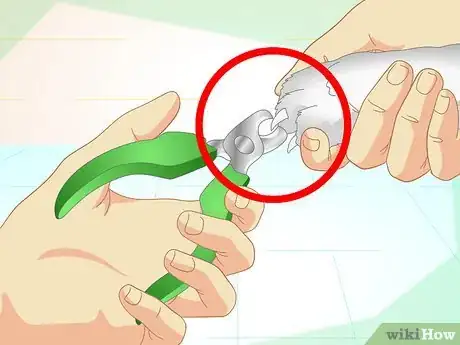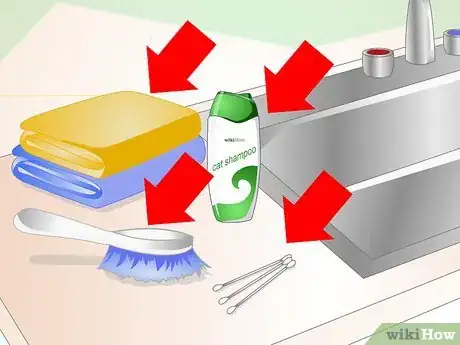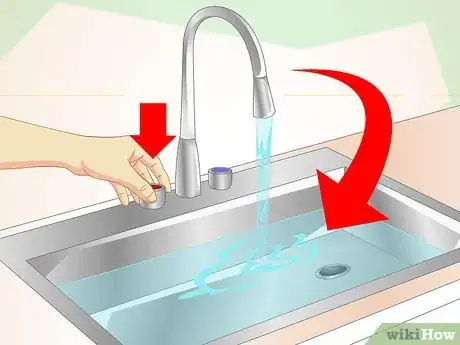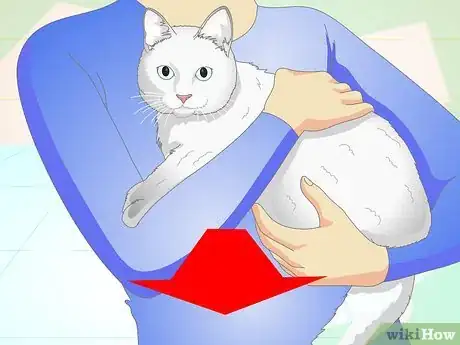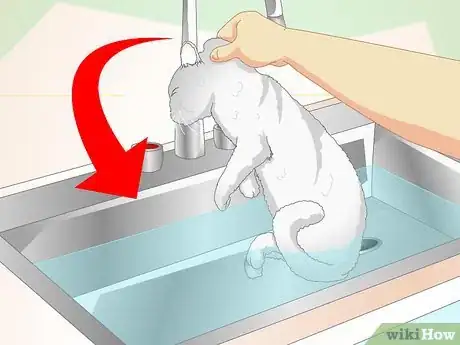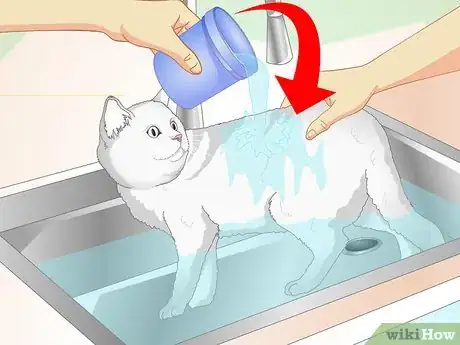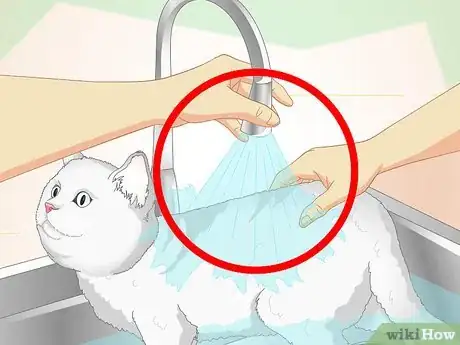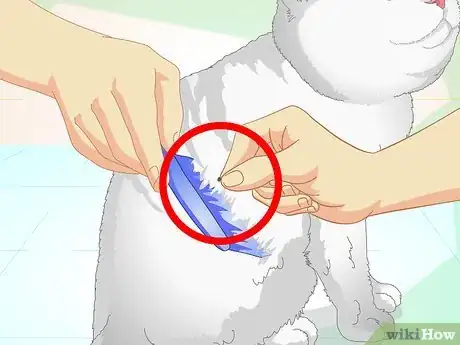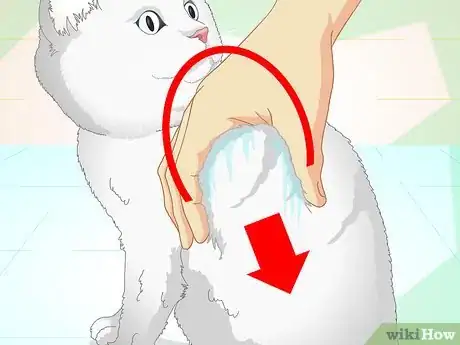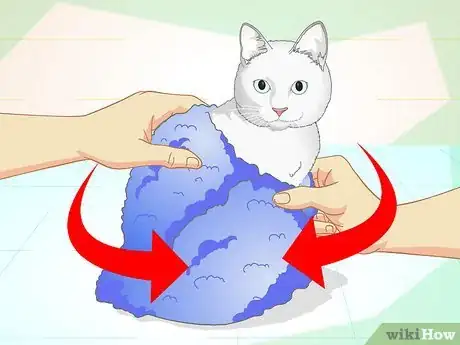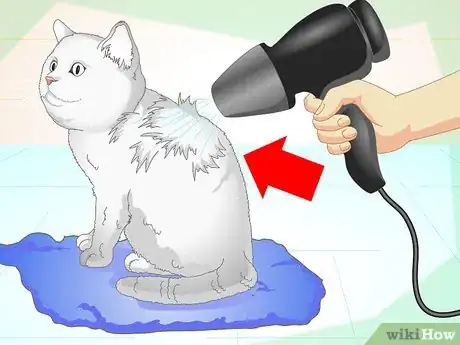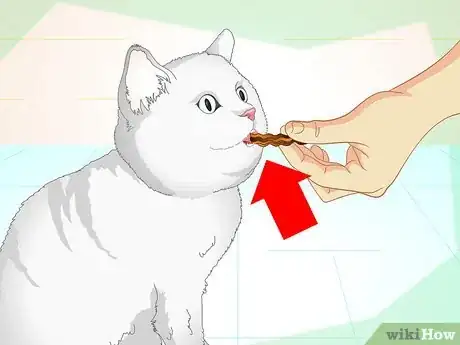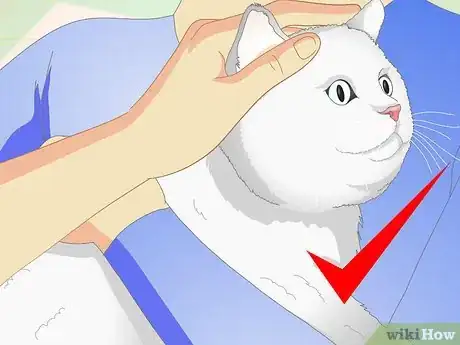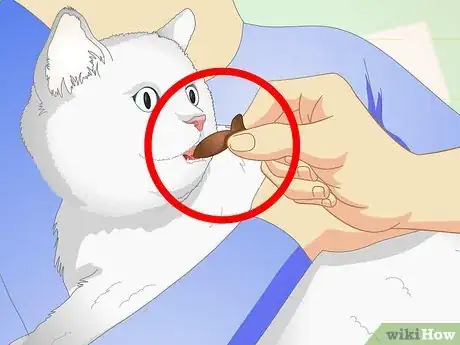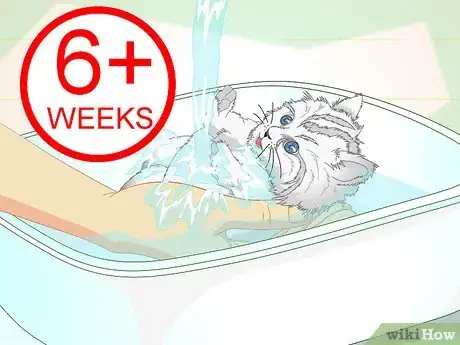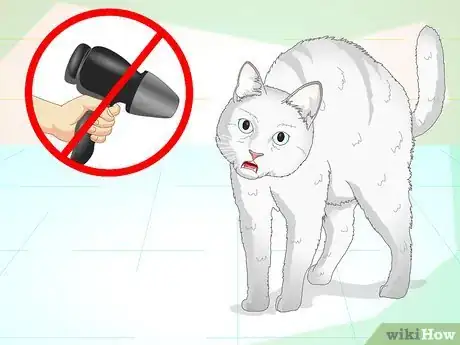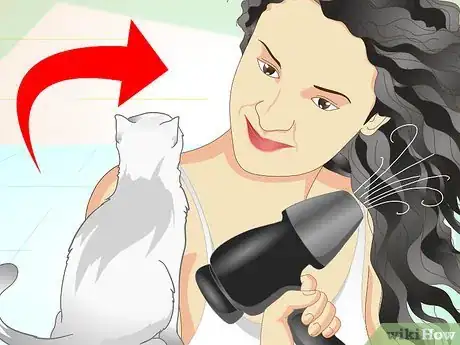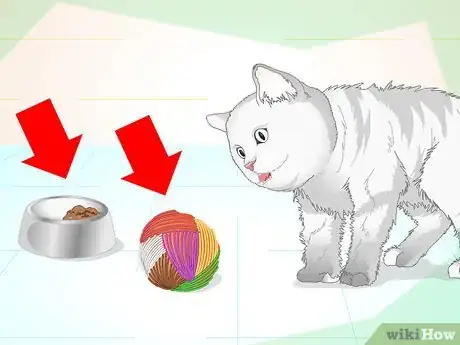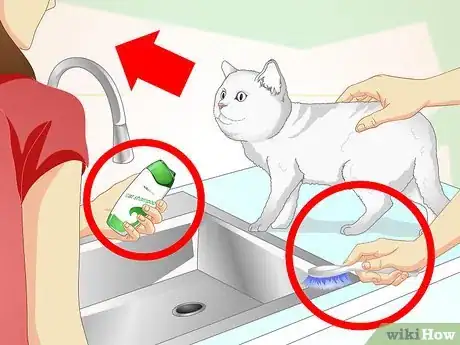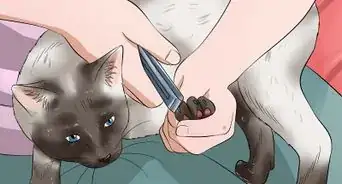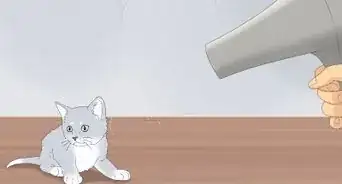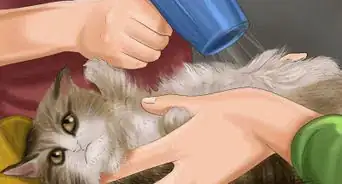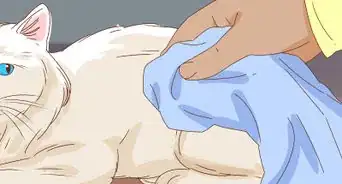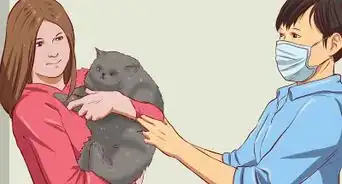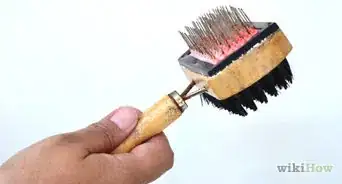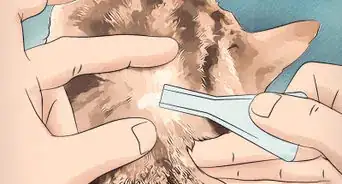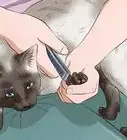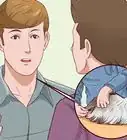This article was co-authored by Pippa Elliott, MRCVS. Dr. Elliott, BVMS, MRCVS is a veterinarian with over 30 years of experience in veterinary surgery and companion animal practice. She graduated from the University of Glasgow in 1987 with a degree in veterinary medicine and surgery. She has worked at the same animal clinic in her hometown for over 20 years.
This article has been viewed 48,101 times.
Bathing cats can be tricky, especially since most cats dislike getting wet. In many cases, however, cats require bathing to promote overall coat health and maintain cleanliness when living in our homes. It is advisable, when possible, to begin bathing cats when they are young, as it gets them used to the practice. If, however, you find yourself bathing a mature cat for the first time, you'll want to ease into the process to ensure no scratches and bites for you, also ensuring as gentle as an experience as possible for the cat.
Steps
Bathing Your Cat
-
1Trim the claws. Your cat may not be aggressive at all; however, if it is stressed during the bathing process, even the most gentle kitty can accidentally scratch its owner while trying to get out of the tub or attempting to escape drying.[1]
- You want the cat to be in the best mood possible before bathing to ensure less stress during the bathing process, so you don’t want bathing associated with any other activity the cat deems disagreeable. If your cat dislikes claw trimming, do so a few days ahead of the bathing process. This dissociates the two events for the cat.
-
2Prepare the bathing area. Get your towel(s), pet shampoo, a container of treats, petroleum jelly or cotton balls for its ears, a comb and brush, and anything else required for the bathing. Put items in a convenient location so that you can handle the cat in the tub or sink and still reach them.
- If you are bathing for fleas, a comb can help remove the stunned fleas from the cat’s coat without intensive searching. Be sure to use a shampoo specifically for flea treatment.
- Having a small cup on hand can be helpful for initially wetting the cat’s coat and rinsing, especially with long-haired cats.
- Many pet stores carry products that are formulated to relax cats via pleasant scents. Consider scenting the bathing room with this type of product to create added calm.
Advertisement -
3Run water in the tub. Fill the tub or sink with warm (not hot) water. Be sure that it will come up no higher than the cat’s belly.
- Remember that your cat is an animal with strong instincts. You want enough water to wash but not so much that the cat might fear drowning and panic.
-
4Bring your cat to the room. It may be easier to lure the cat with a toy or treat, as this will seem less suspicious. You can also simply pick up the cat and bring it to the room where it will be bathed. Close the door behind you if that is an option.
- Bathrooms with a tub are ideal for adult cat bathing because they are small, with few places to hide, and usually have a door that can be closed, keeping the cat from running away if it becomes distressed.
- If you have back problems that prevent you from leaning into a bathtub, consider bathing your cat in the kitchen sink. It may also be helpful to have another person on hand to help keep the cat still during bathing.
-
5Prepare the cat for bathing. Your cat may be stressed and paranoid because of the water, being closed in a room, or other unfamiliar sensations. Reassure the cat by petting and talking to the cat in soothing tones. Calm the cat as much as possible. Sit in the room with the water, letting the cat sniff the water and/or become adjusted to its location.
- This is also a good time to insert cotton balls or, if your cat is resistant, put a layer of petroleum jelly on the area surrounding the opening of the cat’s ears. Just a little will do, on the area where the fur in thin, just outside the ear opening. Either the cotton balls or the petroleum jelly will ensure no water gets in the ear.[2]
- If experience or suspicion indicates that your cat is a struggler, consider putting it in a cat harness for bathing. While this can add to discomfort and stress, it is better to have the harness to grab onto than letting a panicked cat break free and create a predator-prey association when you go to return it to the bath.[3]
-
6Put the cat in the water. Grasp the cat by the nape of its neck, using the loose skin between its head and shoulders. Pick it up gently, scooping the hind legs with your other hand, reminding the cat that it is secure and stable. Slowly lower the cat into the sink or tub, removing your hand from its lower half but keeping your hand on its nape.
- Grasping the cat’s nape (called “scruffing”) is useful is a form of restraint if the cat is struggling. This is the way their mother used to grasp them when she wanted to restrain or carry them and cats of any age respond instinctually by curling up and/or going limp. Scruff only when needed, using other mild forms of restraint if the cat is not fighting you. [4]
- For some cats, they are calmer and more secure if the owner sits in the tub with them during the bath. This should only be done if you know the cat will not use force to get away from you.
-
7Wet the coat. Keeping one hand free to restrain the cat, use a small cup to scoop water onto the cat’s coat wetting the entire body except the head.
- If you have a tub with a removable showerhead or a sink with a sprayer tool, you can use this to wet the cat’s coat.
- It is important not to get water in the cat’s ears as this can cause ear infections.
- To wet the cat’s head, tilt the head up. Placing the cup, showerhead, or sprayer between the cat’s ears, pour or spray water so that the run off only falls behind the cat’s head.
- You should not have to wet the whole head, just the top and the back of the neck. If you want to clean the face around the mouth and eye areas, use a wet wash cloth.
-
8Shampoo the coat. Use the hand not restraining the cat to drizzle a small amount of shampoo onto the cat’s coat. Set the shampoo bottle in an easy to reach location, and proceed to work the shampoo into the cat’s coat. Add more shampoo if needed.[5]
- If you must clean the cat’s face, add a few drops of shampoo to a wet washcloth and gently wash the face, using a stroking motion that goes along with the grain of the hair.
- If you are bathing the cat for fleas, you’ll want to work the shampoo into the body fur first, making sure to include the tummy, then shampoo the cat’s tail, legs and head. When they sense a threat like water, fleas instinctually migrate to the cat’s extremities. When you shampoo the body first, you ensure that, if the fleas attempt to return to the cat’s body fur, they are exposed to the shampoo and are stunned
-
9Rinse the coat. Drain the tub with the cat still inside. Using the showerhead, sprayer, or cup, rinse the coat using the same technique described for wetting the coat. Make sure that there is no residue of soap in the cat’s coat, as this can actually attract dirt once the cat is dry.
- If rising with a cup, turn the faucet on lightly so that it produces a very small stream (this is to avoid panicking the cat with a full-blast gush of water). Leave the water running. Now fill the cup with water and pour it over the cat, repeating until the coat is free of soapy residue.
-
10Remove fleas. If flea removal is the goal of the bath, after rinsing the fur, begin by running the comb from neck to the base of the tail, then combing the sides from the shoulder to the back leg. This creates grooves in the cat’s coat and make it easier to spot fleas. If using a flea comb, it will also help remove fleas and eggs.[6]
- The comb may remove some fleas, but you can use your fingers to remove any other fleas you notice.
- If your cat is lightly colored, you can easily see fleas stuck in the wet fur. You can also feel for fleas in the coat, as larger fleas present small, seed-like lumps.
- Work over the cat’s coat methodically, attempting to remove as many fleas as possible. Also, don’t forget to check the cat’s tummy, as this is a favorite hiding spot.
Drying Your Cat
-
1Squeezing water out of the coat. Once you’ve completed bathing and rinsing, you’ll begin the drying process by gently squeezing as much water as you can from the cat’s coat, focusing on the tail, legs, and feet.
- With the hand not restraining the cat, form a “U” shape. Settle the u-shape over the cat’s shoulders.
- Apply gentle pressure while pulling it from the cat’s shoulders to hips. You’ll notice this pushing water down and away from the top of the back.
- Gently grasp the tail and, with gentle pressure, pull your hand from base to tip. You should see water running off the cat into the tub. Do this to the legs and feet as well, squeezing the paw lightly to free water from the thicker fur around the toes.
- Repeat this process a few times, being sure to also gently squeeze the fur around the tummy.
-
2Use a towel. Once you’ve removed as much water as possible from the cat, use the hand not restraining the cat to spread a towel out on the floor. [7]
- Pick the cat up, remembering to support the back legs with the hand not scruffing it, lifting it from the tub or sink, and gently lowering it onto the towel.
- Use the hand not restraining the cat to gently fold the towel over and around the cat until it is partially covered. Use the same hand to gently rub the towel over the cat’s body in a back and forth motion. You’ll want to rub as much of the body as possible. If the cat doesn’t seem inclined to run, you can use both hands.
- Use a second towel if needed, continuing to rub the coat until it is semi-dry and fuzzy. Afterwards, use a comb to flatten the fur, being sure to comb in the direction that the fur typically lays. At this point, the cat can be given treats, reassured with pets and verbal soothing, calmed, then released and left to groom itself.
-
3Using a hairdryer. It is recommended that you do a brief, preliminary dry with a towel before using the hairdryer. Additionally, you should only use the hairdryer if you believe the cat will not panic because of the noise it produces.
- Unwrap the cat from the towel, but leave it sitting on it. Be sure to restrain it if it seems likely to run.
- With the hand not restraining the cat, grasp the handle of the hair dryer and put it on its lowest heat setting and speed. Turn it on, being sure to let the cat get used to the noise before using it. If the cat panics and cannot be calmed, turn off the dryer and continue to dry with the towel.
- If the cat accepts the hairdryer noise, turn the dryer so that the cat can feel the air coming from it. If the cat continues to remain calm, bring the hair dryer closer and begin drying, using a back and forth shaking motion with the dryer to make sure that the heat and air is dispersed and not too focused.
- If the cat seems calm, you can increase the drying speed and also re-situate it so that the cat is held between your upper legs, facing your feet, using one hand to dry the cat with the dryer and the other hand to fluff the fur while drying. If the cat will tolerate it without struggling, this expedites the drying process significantly.[8]
- Dry the cat until the coat is mostly dry and fluffy. The legs and tail may still be slightly wet, but these will dry quickly once the cat is allowed to begin grooming.
Calming the Cat After Its Bath
-
1Offer treats. Your cat has just been through a completely unnatural experience and is probably exhausted, a little skittish, and may even believe the bath was a punishment. Remind the cat that you are its friend and that it is not in trouble by offering it some of its favorite treat.
- Post-bath grooming for your cat means that it may ingest a good deal of hair. Consider treating your cat with specially formulated “hairball treats.” These contain a greater amount of fat or fish oil, which will stick to the fur in the cat’s stomach, helping the fur pass through the digestive system and preventing hairballs.
-
2Pet the cat. While treating it, pat and stroke the cat gently, talking and telling it what a good kitty it is, reassuring it that everything is back to normal and that it doesn’t need to be afraid.
- If your cat is a fan of being brushed, begin the grooming process by using its favorite brush to start removing hair that has been released due to stress and bathing.
-
3Continue to pet, treat, and soothe before release. Don’t release the cat until its body language tells you it has relaxed and is not afraid. Look for signs like tail lifting, purring, closing or partially closing the eyes, bunting (nuzzling its head against your hands or body), or any other signs you recognize as indicating your cat is happy.
- When the cat body emotes calm energy, release it. It will likely find a comfy, out of the way spot to begin its own grooming process. Give it a few hours to groom, nap, and feel normal again. Let it come find you when it’s ready for interaction.
Training your Cat for Bathing and Drying
-
1Begin bathing the cat when it is a kitten. If you own the cat as a kitten, start bathing it as soon as possible. It is much easier to restrain a tiny kitten as opposed to a mature cat. Also, kittens are very responsive to being scruffed, and doing so reinforces the activity for future interactions.
- Wait until it is at least 6 weeks old before bathing, as any earlier could lead to illness or other health complications.
- For small kittens, begin bathing in the bathroom sink. This is shallow and a better fit, size-wise. It also enables you to rinse easily using the faucet, normalizing the sound and sensation of running water.
- Consider bathing and drying the kitten once every 2 weeks for 3 months. This avoids complication of over-bathing (like dry skin) while also normalizing the bath process as a part of grooming.
-
2Avoid stress or shock. Never use bathing or hair dryers as a punishment for cats and avoid any event or form of interaction that might give the cat a negative experience with your bathroom or sink, depending on where bathing will occur.
- This includes not using the bathroom for cat time-out when negative behavior occurs.
-
3Create familiarity. Part of demystifying the bathing process for a cat and making it less stressful is letting your cat become accustomed to the noises, smells, and sensations of the process.
- When you are showering or drying your hair, give your cat access to the space(s) where these activities take place. Cats are very curious of novel experiences and will probably invite themselves into these rooms to investigate what is going on.
- Ignore the cat as you go about your routine. Cats are independent by nature and it can be helpful to let the cat elect into these experiences of their own free will and normalize these sounds and sensations, independent of human influence.
-
4Enable positive associations. Before showering or drying your hair, consider leaving treats or a favorite toy in the room within sight of bathing or hair drying. This can entice the cat to come into the room and create positive feelings around doing so.
- Avoid offering the cat toys or treats directly as, when combined with the sounds and smells of running water and hair drying, this can be overwhelming and might inadvertently be interpreted as threatening to a stressed cat. Remember, you want to ignore the cat while it’s learning to process these new experiences.
- Reassure the cat. When the cat is comfortable with the noises, it may signify it is approachable by relaxing its body language, resting in or near the room where the noises are happening, or spending time in the bathroom with you while you are bathing or drying your hair. Some cats become comfortable enough to actually get in the shower with their owner. When the cat demonstrates it has normalized bathing and hair drying, praise it.
- Preempt the drying process by rubbing your cat with a towel as part of play. Some cats enjoy being covered or creating fabric “caves” as a part of play, and will take to the towel readily. Others may need a bit of coaxing, but try to familiarize the drying process by putting toys under the towel or putting you hand under the towel and moving it, simulating a small animal the cat might like to hunt. Encourage the cat to get under the towel while playing, normalizing the smell, feel and experience of interacting with the towel.
-
5Get help from a friend or family members. Get family members involved in the effort to familiarize bathing and drying with the cat. If you are bathing a cat for the first time, consider having a family member or friend the cat knows on hand to help with the process and ensure it goes smoothly.
Expert Q&A
-
QuestionAre you supposed to bathe a cat?
 Pippa Elliott, MRCVSDr. Elliott, BVMS, MRCVS is a veterinarian with over 30 years of experience in veterinary surgery and companion animal practice. She graduated from the University of Glasgow in 1987 with a degree in veterinary medicine and surgery. She has worked at the same animal clinic in her hometown for over 20 years.
Pippa Elliott, MRCVSDr. Elliott, BVMS, MRCVS is a veterinarian with over 30 years of experience in veterinary surgery and companion animal practice. She graduated from the University of Glasgow in 1987 with a degree in veterinary medicine and surgery. She has worked at the same animal clinic in her hometown for over 20 years.
Veterinarian Healthy cats, especially those with short coats, don't need bathing. It's really only long-haired cats or show animals that may need an occasional wash. The other group which may need bathing are cats belonging to people with cat allergies. Washing reduces the amount of dander (allergen) on the cat and relieves the allergy symptoms.
Healthy cats, especially those with short coats, don't need bathing. It's really only long-haired cats or show animals that may need an occasional wash. The other group which may need bathing are cats belonging to people with cat allergies. Washing reduces the amount of dander (allergen) on the cat and relieves the allergy symptoms. -
QuestionHow can I clean my cat without water?
 Pippa Elliott, MRCVSDr. Elliott, BVMS, MRCVS is a veterinarian with over 30 years of experience in veterinary surgery and companion animal practice. She graduated from the University of Glasgow in 1987 with a degree in veterinary medicine and surgery. She has worked at the same animal clinic in her hometown for over 20 years.
Pippa Elliott, MRCVSDr. Elliott, BVMS, MRCVS is a veterinarian with over 30 years of experience in veterinary surgery and companion animal practice. She graduated from the University of Glasgow in 1987 with a degree in veterinary medicine and surgery. She has worked at the same animal clinic in her hometown for over 20 years.
Veterinarian Brushing and combing are good at removing dry contaminants from the coat, such as pollen, dust, or grit. If there is a sticky knot, then slide a comb below the knot to protect the skin and clip the tangle away. For a dirty bottom or smelly area, try using unscented baby wipes to clean the area, then dry it well afterwards with disposable kitchen towels.
Brushing and combing are good at removing dry contaminants from the coat, such as pollen, dust, or grit. If there is a sticky knot, then slide a comb below the knot to protect the skin and clip the tangle away. For a dirty bottom or smelly area, try using unscented baby wipes to clean the area, then dry it well afterwards with disposable kitchen towels. -
QuestionDo you need to bathe a cat?
 Pippa Elliott, MRCVSDr. Elliott, BVMS, MRCVS is a veterinarian with over 30 years of experience in veterinary surgery and companion animal practice. She graduated from the University of Glasgow in 1987 with a degree in veterinary medicine and surgery. She has worked at the same animal clinic in her hometown for over 20 years.
Pippa Elliott, MRCVSDr. Elliott, BVMS, MRCVS is a veterinarian with over 30 years of experience in veterinary surgery and companion animal practice. She graduated from the University of Glasgow in 1987 with a degree in veterinary medicine and surgery. She has worked at the same animal clinic in her hometown for over 20 years.
Veterinarian No. Most cats excel at grooming and will keep their coat in good order. However, if you have a long-haired cat, sometimes they will soil themselves, in which case a wash may be needed.
No. Most cats excel at grooming and will keep their coat in good order. However, if you have a long-haired cat, sometimes they will soil themselves, in which case a wash may be needed.
Things You'll Need
- A sink or bathtub
- Cat shampoo
- A comb and/or flea comb
- Bath towels
- Cat treats
- A small cup
- Cotton balls or petroleum jelly
Warnings
- Always use a shampoo formulated for a cat’s coat. Using human shampoo can cause residue to build up in the cat’s coat. Additionally, using dish detergent or other cleansers can irritate the cat’s skin and, in some cases, cause rashes or blistering.⧼thumbs_response⧽
- For the sake of safety and not stressing your pets unnecessarily, do not bathe more than one cat at the same time. While there are some cats that do not object to bathing and actually like water, most cats find the bathing experience stressful and handling more than one frantic cat at a time could lead to injury for all parties involved.⧼thumbs_response⧽
- Some cats, like people, have phobias. If your cat is particularly stressed by noises or new sensations, or you’ve attempted the bathing process and it was traumatic for the cat as opposed to just stressful, it is likely better for both of you that you not bathe the cat. This prevents the cat from associating negative, traumatic experiences with you, its caregiver. If the cat requires regular bathing for health reasons, your vet’s office or a groomer can provide this service for a minimal fee.⧼thumbs_response⧽
- Some cat owners dry cats by placing them in a pet carrier and putting a hair dryer outside the door, blowing into the carrier. This is not recommended, as it can cause the cat to overheat and has led to death in some cases.⧼thumbs_response⧽
References
- ↑ https://www.aspca.org/pet-care/cat-care/bathing-your-cat
- ↑ https://www.aspca.org/pet-care/cat-care/bathing-your-cat
- ↑ http://www.catster.com/lifestyle/bathe-cat-care-without-bloodshed
- ↑ http://www.petmd.com/blogs/fullyvetted/2013/oct/restraining-cats-the-right-way-not-scruffing-30997
- ↑ http://pets.webmd.com/cats/bathing-your-cat
- ↑ http://www.fleabites.net/flea-comb-how-to-use-it/
- ↑ https://books.google.com/books?id=R63DBTUjzEwC&pg=PA133&lpg=PA133&dq=how+to+towel+dry+a+cat&source=bl&ots=SE9au7cbm8&sig=nhq4mfqg7Y27cp7oFUbqZSSzI8k&hl=en&sa=X&ved=0CCoQ6AEwAjgKahUKEwiWz5Scq8XIAhXIfogKHZ1BDBw#v=onepage&q=how%20to%20towel%20dry%20a%20cat&f=false
- ↑ http://www.catster.com/lifestyle/bathe-cat-care-without-bloodshed
About This Article
To inconspicuously bathe your cat without being scratched, make sure to trim its nails before bath time and to reassure it by petting and talking to it in soothing tones before putting it in the water. When you fill your tub or sink with bath water, make sure it warm, not hot, and only comes up to your cat’s belly, otherwise it might fear drowning and panic. Once it’s calm, grab your cat by the loose skin between its head and shoulders, scoop the hind legs with your other hand, and slowly lower it into the water. During the bath, keep one hand on your cat to restrain it as and use the other to shampoo and then rinse by scooping water with a small cup. For more help from our Veterinary co-author, like how to dry your cat safely, read on!
